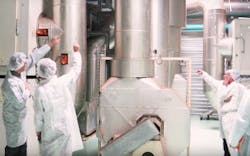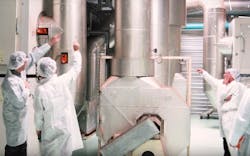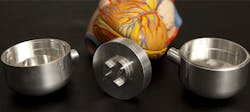Although some definitions of “innovation” require that it have been introduced to market, I prefer a broader definition, especially as it relates to technology. Merriam-Webster keeps it simple: the introduction of something new (or) a new idea, method, or device.
Writing about innovative technologies, with eco-sustainable impacts, has been a priority for me. In the first eight months of this year, I focused on six of what I consider to be breakthrough technologies that have the potential to significantly reduce carbon emissions, without requiring us to abandon all of our creature comforts.
The first of these, in January, was the thermogalvanic brick, developed by scientists from King’s College (London), Arizona State University, and the University of New South Wales (Sydney, Australia). Working together as part of the PLuS Alliance, the three leading research universities aim to solve global challenges in the areas of health, social justice, sustainability, technology and innovation. The “brick” is actually a galvanic cell, similar to a conventional lead-acid battery in that it has dissimilar metal electrodes immersed in an electrolyte solution.
In most galvanic cells, an electrochemical reaction causes an electric current to flow between the electrodes. In a thermogalvanic cell, a temperature differential between the electrodes — which may be similar metals —results in an electromotive potential. The thermogalvanic brick generates electricity when the interior and exterior faces of the brick are maintained at different temperatures. So a structure built with these bricks will produce electricity when exposed to the sun, much like a solar photovoltaic cell.
For emergency housing or storage, or housing in developing countries, this could literally be a life changer.
Next in my favorite innovations of 2019, in March, I wrote about another type of electrochemical cell: the fuel cell. But not just any fuel cell. This fuel cell, developed by researchers at the Ulsan National Institute of Science and Technology in South Korea, produces electricity with hydrogen — not water — as its byproduct and water instead of hydrogen as its fuel. Because hydrogen is considered a “clean” (zero carbon emission) fuel, this hybrid fuel cell, if scaled up to commercial capacity, could be used in such applications as desalination of sea water, since both the salt and the hydrogen required for its operation would be plentifully available. The fuel cell would produce fresh water, electricity, and hydrogen for use as a fuel.
Waves of the Future
Also in March, I wrote about a wave energy converter, developed by a team of Scottish and Italian engineers from the University of Edinburg, the University of Trento, Bologna, and the Sant’Anna School of Advanced Studies in Pisa. Using a dielectric elastomer (flexible rubber membrane) generator, the prototype wave energy generators produced nearly 4W in the approximately 80-ft-dia.-x-7-ft-deep test tank. The team believes that at commercial scale, the system could provide low cost power to 100 coastal homes.
In April, my hit parade of innovations selection was what the U.S. Dept. of Energy and the EU Commission have called “the most promising alternative technology to existing vapor-compression refrigeration systems.” Developed by researchers at Saarland University in Saarbrucken, Germany, this device uses so-called “muscle wire” — that is, shape-memory metals that remember their original shape and return to it after being deformed. In this case, the muscle wire, made of nickel-titanium, releases heat when it is mechanically loaded. Then, when unloaded, it absorbs heat from its surrounding fluid. The prototype was able to cool air by continuously loading and unloading muscle wire bundles.
Since it doesn’t use any refrigerants, it’s environmentally friendly and according to the researchers, it’s two to three times more efficient than vapor-compression refrigeration. When used to replace water-cooled air conditioners or heat pumps, it would also eliminate the need for high-pressure piping or intermediate heat exchangers.
Also in April, I followed up on that hydrogen producing hybrid fuel cell discussed in March, with a description of a solar-powered electrolyzer. Developed by a team of scientists at Stanford University and Beijing University of Chemical Technology, the electrolyzer can use untreated seawater as its “fuel”.
The research team was able to develop both a multi-layer electrode to resist saltwater corrosion, and a catalyst that repels salt molecules. Their prototype produced 400 mA/cm2 at 2.1 V with real seawater, and showed no degradation after 1,000 hours of operation. Commercialization of this technology could result in pollution-free power plants using seawater as their fuel.
July’s focus was on another breakthrough from the Ecole Polytechnique Fédérale de Lausanne (EPFL), a Swiss university and research institute that specializes in science and engineering. According to their website, EPFL publishes an average of 382 scientific articles each month, so it’s no surprise that this is the second shout-out that I’ve given them this year. This latest noteworthy innovation is EPFL’s use of artificial intelligence (AI) to develop microturbocompressors to energy-efficient heat pumps. These small diameter (less than one inch) microturbocompressors rotate at speeds up to 500,000 RPM, but their very low friction make them more energy efficient than conventional heat pump compressors, resulting in 20-to-30 percent higher heat transfer coefficients. Since the design of these small, low-friction, high-speed wheels is extremely complex, the EPFL team used artificial intelligence (AI) to run hundreds of thousands of high-speed simulations.
Behold, the Mechanical Heart
Finally, although I haven’t yet written about it, and it has nothing (and everything) to do with our industry, my pick for the best innovation so far this year is the Bivacor artificial heart. Historical artificial heart designs have relied on mechanical pumps modeled after the four chambers of the human heart.
Since the human heart, at an average rate of 80 times per minute, will beat 42 million times in a year (that’s more than 3 billion times in an average life), designing a reliable mechanical pump has been a formidable challenge. The Bivacor heart was developed by Daniel Timms, Ph.D. Dr. Timms is a biomedical engineer who has been working on this project since 2001, when his father was diagnosed with a serious heart condition. The device has only one moving part, using a spinning disc suspended in a magnetic field (similar to maglev chiller compressors), to pump blood through a body’s circulatory system. Earlier this year, the Texas Heart Institute implanted a Bivacor heart into a cow, for a successful 90-day trial.
To date, there have been at least 15 cows and several sheep implanted with the device, and researchers are moving toward human trials. The Bivacor heart is encased in titanium, which is corrosion-resistant and inert in the human body to avoid rejection. When this device completes human trials and is approved by the FDA, it will have the potential to save millions of lives.
These innovations, as remarkable as they all are, represent only a fraction of the technological breakthroughs that have happened so far this year. As Arthur C. Clarke, one of my favorite authors when I was a youngster, put it so well: “Any sufficiently advanced technology is equivalent to magic.”
A regular contributor to HPAC Engineering and a member of its editorial advisory board, the author is a principal at Sustainable Performance Solutions LLC, a south Florida-based engineering firm focusing on energy and sustainability.
About the Author
Larry Clark
A member of HPAC Engineering’s Editorial Advisory Board, Lawrence (Larry) Clark, QCxP, GGP, LEED AP+, is principal of Sustainable Performance Solutions LLC, a South Florida-based engineering firm focused on energy and sustainability consulting. He has more than two dozen published articles on HVAC- and energy-related topics to his credit and frequently lectures on green-building best practices, central-energy-plant optimization, and demand-controlled ventilation.




